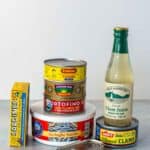Italian Cheeses
Cheese is essential in a well stocked Italian pantry. With over 2500 varieties, Italy is the country with the largest variety of traditional cheeses in the whole world. Mozzarella, Pecorino, and Parmigiano just barely scratch the surface. Keep reading to learn about the wonderful world of Italian cheeses!
This post may contain affiliate links.

While France is the top producer of cheese in terms of quantity, Italy follows right after. Out of the 2500 varieties of traditional cheeses produced in Italy, 500 are commercially recognized cheeses which are also exported abroad, and more than 300 have a protected designation of origin, which ensures quality and high standards.
If you thought Italy had only mozzarella and Parmigiano, you need to think again! You'll be amazed by the delicious wide offer of cheeses with different flavors and texture Italy has to offer.
History and Culture
Italian cheese-making dates back to ancient times, with evidence of cheese production as early as 3000 BC. The Roman Empire played a significant role in spreading cheese-making techniques throughout Europe.
Over the centuries, Italian cheese producers perfected their craft, and many of the cheeses we know today have been made using the same methods for hundreds, if not thousands, of years, with each Italian region developing its own cheese specialties.
Popular Types of Italian Cheeses
Italy is divided into different regions, each with its own unique traditional cheese varieties.
Northern Italy
- Fontina (Valle d'Aosta): A semi-soft cheese with a rich, nutty flavor, Fontina is made from unpasteurized cow’s milk. It’s often used in fondue or raclettes (it has an amazing cheese pull when melted) and pairs well with hearty mountain dishes.
- Gorgonzola (Lombardy): The famous blue cheese comes in two varieties: Dolce (sweet) and Piccante (spicy). It has a creamy texture with a distinct, tangy flavor.
- Grana Padano (Lombardy): Similar to Parmigiano Reggiano, Grana Padano is a hard cheese with a crumbly texture and a rich, savory flavor. It’s aged for at least 9 months.
- Asiago (Veneto): Asiago cheese can be found in two forms: fresh (Asiago Pressato) with a soft texture and mild flavor, and aged (Asiago d’Allevo), which is harder and more intense in flavor.
- Taleggio (Lombardy): Taleggio is a soft, washed-rind cheese with a strong aroma and a mild, tangy flavor. It has a creamy texture that becomes more pronounced as it ages.
- Stracchino (Lombardy): Also known as Crescenza or Squaquerone, Stracchino is a soft, fresh cheese with a mild, slightly tangy flavor. It’s often spread on bread or used in focaccia fillings.
- Mascarpone (Lombardy): Mascarpone is a rich, creamy cheese made from cream, with a smooth texture and a sweet, buttery flavor. It’s commonly used in desserts like tiramisu but also works well in savory dishes.
Central Italy
- Parmigiano Reggiano (Emilia-Romagna): Known as the “King of Cheeses,” Parmigiano Reggiano is a hard, granular cheese with a sharp, complex flavor. It’s aged for at least 12 months, and sometimes up to 48 months.
- Pecorino Romano (Lazio): Made from sheep’s milk, Pecorino Romano is a hard, salty cheese often used for grating over pasta. It has a bold, tangy taste.
- Ricotta (Lazio): Ricotta is a soft, creamy cheese made from the whey leftover from other cheeses. It has a mild, slightly sweet flavor and is often used in desserts, as well as in savory dishes.
- Scamorza (Abruzzo): This semi-soft cheese is similar to mozzarella but with a much firmer texture and a milder flavor. It’s often smoked to give it an extra layer of taste. Scamorza also has an amazing cheese pull when melted.
Southern Italy
- Mozzarella di Bufala (Campania): Made from the milk of water buffalo, this cheese is soft, creamy, and slightly tangy. It’s the star of many Italian dishes, including the classic Caprese salad.
- Mozzarella (Campania): While Mozzarella di Bufala is made from buffalo milk, traditional Mozzarella is made from cow’s milk. It’s a fresh cheese with a mild flavor and a springy texture, perfect for melting on pizza or enjoying fresh in salads. In Italy it's always enjoyed fresh, straight out of its water. Dried grated cheese called mozzarella, has nothing to do with real mozzarella cheese.
- Provolone (Campania): A semi-hard cheese with a smooth texture, Provolone can be mild or sharp depending on how long it’s aged. It’s often used in sandwiches and melted over dishes.
- Caciocavallo (Puglia): Shaped like a teardrop, this semi-hard cheese has a tangy, slightly spicy flavor. It’s traditionally hung to age, which gives it a unique texture.
- Burrata (Apulia): A decadent cheese made from mozzarella and cream, Burrata has a soft, buttery center that oozes out when cut. It’s best enjoyed fresh, with just a drizzle of olive oil.
Quality and Authenticity
When buying Italian cheeses, it’s important to look for quality and authenticity. Many traditional Italian cheeses are protected by the European Union’s Denomination of Protected Origin (DOP) label. This label guarantees that the cheese was made in a specific region using traditional methods. Cheeses with the DOP label are of the highest quality and offer the true taste of Italy.
How to Recognize Authentic Italian Products
To ensure you're getting authentic Italian cheese, look for the following:
- DOP Label: As mentioned above, the DOP label is a sign of authenticity.
- Origin: Check where the cheese was produced. Authentic Italian cheeses will always indicate the specific region of production.
- Packaging: Authentic cheeses are often sold in packaging that includes the name of the cheese, the producer, and the region of origin. Be wary of generic labels or packaging that lacks specific details.
- Consortium Logo: Some popular cheeses, like Parmigiano or Grana Padano, must also have a consortium trademark logo on the package to guarantee authenticity. Look for the authentic logo that authorizes resale.
Uses in Italian Cuisine
Italian cheeses are incredibly versatile and are used in a wide variety of dishes. Here are some common uses:
- Pizza: Mozzarella is the go-to cheese for pizza, but other cheeses like Gorgonzola or Provolone can be used as well for a different flavor profile, or like in the Pizza Quattro Formaggi.
- Pasta: Hard cheeses like Parmigiano Reggiano and Pecorino Romano are often grated over pasta dishes for added flavor.
- Salads: Fresh cheeses like Mozzarella di Bufala, Burrata, and Stracchino are perfect in salads, adding a creamy texture and rich flavor.
- Desserts: Mascarpone and Ricotta are commonly used in Italian desserts, such as tiramisu, cannoli, and ricotta pie.
- Snacking: Many Italian cheeses, especially those that are aged, are delicious on their own or with a simple accompaniment of bread and olives.
More recipes using Italian cheeses:
- Grilled Peach Panzanella Salad with Burrata
- Neapolitan Style Pizza Margherita
- Scaccia Ragusana: Sicilian Stuffed Bread
- Honey Roasted Plum Crostini with Burrata + Prosciutto
- Fava Bean Crostini with Pecorino and Mint
- Easy Shaved Asparagus Salad Recipe with Pecorino Romano
- Crispy Roasted Brussels Sprouts with Pecorino + Herbs
- Easy Baked Eggplant Parmesan
- Spinach with Butter + Parmesan
- Crispy Baked Parmesan Truffle Fries
- Mascarpone Stuffed French Toast
- Rigatoni with Italian Sausage, Mascarpone + Walnuts
- Extra Fluffy Blueberry Lemon Ricotta Pancakes
- Classic Italian Ricotta Cake with Pears
Buying and Storing Tips
When buying Italian cheese, freshness is key. Here are some tips to ensure you get the best quality:
- Buy from a reputable source: Specialty cheese shops or markets with a good selection of Italian cheeses are your best bet. These places often have knowledgeable staff who can help you choose the right cheese and offer advice on storage.
- Storage: Most Italian cheeses should be stored in the refrigerator, wrapped in wax paper or cheese paper to allow them to breathe. Avoid plastic wrap, which can trap moisture and lead to spoilage. Hard cheeses like Parmigiano Reggiano can last for several weeks, while soft cheeses like mozzarella and burrata should be consumed within a few days of purchase.
FAQ
Look for the DOP label and consortium logo on the packaging, and check the rind for the “Parmigiano Reggiano” stamp. Authentic Parmigiano Reggiano will also have a sharp, complex flavor and a granular texture.
Freezing can alter the texture of cheese, especially soft and fresh varieties like mozzarella or ricotta. However, hard cheeses like Parmigiano Reggiano can be frozen in small portions if necessary. Wrap the cheese tightly in plastic wrap and place it in a freezer bag. When ready to use, thaw the cheese in the refrigerator.
Italian cheese is best served at room temperature, which allows the full flavors to develop. Take the cheese out of the refrigerator about an hour before serving. Pair it with bread, olives, cured meats, and a glass of Italian red wine for a perfect Italian experience.




